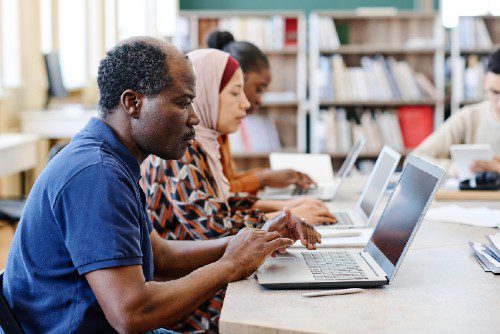
The City of Seattle Community Technology and Technology Matching Fund (TMF) programs began in the 1990s. We more fully integrated an equity approach into our work in 2015, when the City launched the Seattle Digital Equity Initiative. The goal at that time was to research and develop a plan to help ensure all Seattleites had access to, and were proficient in, using digital technologies.
The COVID pandemic shined a bright light on this work. During the pandemic, the City Council passed Resolution 3956, which expanded and rebranded the City’s Digital Equity efforts as Internet for All Seattle. The resulting Internet for All Action Plan contained 49 Action Items. Four primary goals of the Action Plan were:
- Support Seattle Public Schools’ efforts to increase and improve student-household internet access and quality.
- Foster up to 20,000 internet connections and devices for underserved.
- For the 2024 Technology Access and Adoption Study, the data points toward universal internet adoption.
- Significantly increase the internet adoption rate for households with annual incomes under $25,000.
Between 2021 and 2024, the City leveraged partnerships to achieve each of these goals. We received federal grant funds to ensure community members were aware of the Affordable Connectivity Program. Before the federal Affordable Connectivity Program ended in 2024, over 40,000 low-income Seattle households were enrolled, which was double our goal of 20,000 internet connections. We worked with Seattle Public Schools and other partners to improve internet access for student-households and Technology Access and Adoption Study data pointed toward universal internet adoption, including for low-income households.
Today, the news about Digital Equity coming out of Washington, D.C., is alarming, and it has had local repercussions. However, despite a difficult local funding situation, we continue to address remaining gaps in internet access, connected devices, and digital skills through the Technology Matching Fund and other Digital Equity programs. We are expanding on this work and innovating through our Digital Navigator projects and our partnership with Seattle Housing Authority, which has increased its funding support for Digital Equity this year. We also continue to partner with Comcast, Astound, and Lumen to connect Seattle non-profits to free broadband service.
While we celebrate our successes, we also acknowledge the impact of cuts at the federal and state levels.
The Affordable Connectivity Program was not renewed, which directly impacted our community and shut down the City’s Affordable Connectivity Program Outreach Project in early 2024.
The State Digital Navigator grant program ended on June 30. Eliminating this state program has reduced the availability of digital navigation services and technology support for individuals across the state.
The State Digital Equity Capacity Grant is currently in limbo. The Trump administration claimed to have “cancelled” the grant. This grant is the primary source of funds to implement the State Digital Equity Plan, so the State’s ability to implement the Plan is now threatened. The initial focus of the Capacity Grant was on helping people stay safe online, one of the top issues that community members identified during our Tech Access and Adoption Study. This concern is expected to grow as AI becomes more prevalent.
Funds that would have supported digital equity activities in Washington State and across the country through the federal Digital Equity Competitive grant program are also in limbo. Much of the information about this program has been removed from federal government websites. However, the list of agencies that had been tentatively awarded funds by the Biden administration to serve Washington state included these seven non-profits:
- International Rescue Committee
- National Digital Inclusion Alliance
- National Lead For America
- Hispanic Federation
- Washington Technology Industry Association’s Workforce Institute
- Goodwill Industries
- Refugee Women’s Alliance (ReWA)
The Broadband Equity, Access, and Deployment program has also been delayed. The state planning process is continuing and this bipartisan effort to build broadband infrastructure is now once again moving forward, but on a delayed timeline and with changes that will impact the level of broadband service communities receive.
So what can be done? Advocacy is an important step that anyone can take. In King County, Digital Equity advocacy is done by the Digital Equity Learning Network. You can also advocate directly by contacting a member of Congress or a state legislator and letting them know that you support Digital Equity.
Regardless of what happens at the federal or state level, we are committed to this work. In 2025 and beyond, our focus is on:
- Enhancing interdepartmental collaboration and building strategic partnerships to sustain our digital equity programs and continue closing the digital divide.
- Supporting community-driven solutions and community-based agencies that apply for TMF funds, through the Access for All program, and in other ways.
- Improving communications and customer service to ensure the services we offer are available to all Seattle residents. If you are struggling with technology or need help getting or staying connected, you may call us at 206-684-8498 or email us at digitalequity@seattle.gov.
No one should have to struggle to stay connected with their community. Everyone should have access to online tools and resources. As we transition to a new phase of Internet for All, we will continue to stand up for our values, and we will fight short-sighted and fearful attempts to erase equity from government. We will continue to seek opportunities to increase the impact of our programs. And we will continue to work for equity and justice in One Seattle.